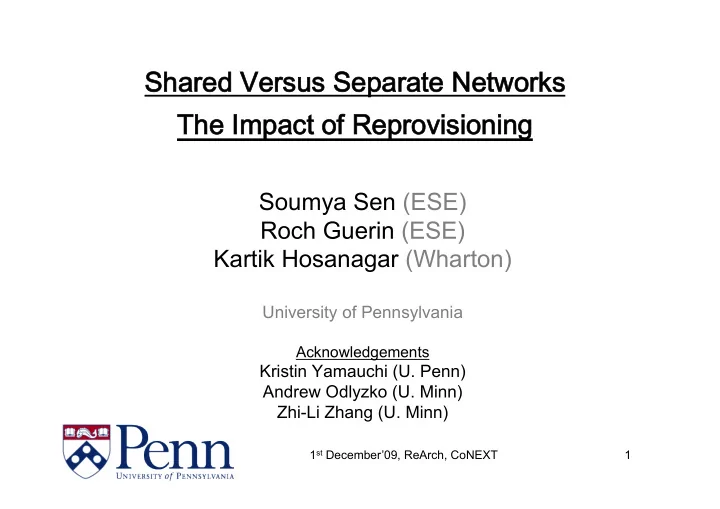

Shared Versus Separate Networks The Impact of Reprovisioning Soumya Sen (ESE) Roch Guerin (ESE) Kartik Hosanagar (Wharton) University of Pennsylvania Acknowledgements Kristin Yamauchi (U. Penn) Andrew Odlyzko (U. Minn) Zhi-Li Zhang (U. Minn) 1 st December’09, ReArch, CoNEXT 1
Overview • Introduction & Motivation • Model • Solution Methodology • Results • Conclusions 1 st December’09, ReArch, CoNEXT 2
Introduction • Innovation creates new network services • How are these services to be deployed? • Key Questions: (1) What is the correct choice of Infrastructure? – Combine services onto a single shared network? – Create dedicated networks for each service? (2) Which economic factors influence the choice and how? 1 st December’09, ReArch, CoNEXT 3
Motivation Examples • IT & Facilities Management services – e.g. Internet & HVAC systems • Video and Data services – e.g. Internet & IPTV services • Broadband over Powerlines 1 st December’09, ReArch, CoNEXT 4
Solution Options • Shared Network Solution Pros: • Possible economies of scope in fixed and variable cost components Cons: • Cost of ‘upgrading’ network features to accommodate services with disparate requirements • Increases operational and troubleshooting complexity • Separate Network Solution Pros: • Easier operation saves costs Cons: • Higher costs of creating dedicated networks • One option: Compare Infrastructure choices based on optimal profit 1 st December’09, ReArch, CoNEXT 5
Technical Considerations • New services have demand uncertainty – Over-provisioning is expensive (unused resources) – Under-provisioning is costly too, but • Dynamic resource “ reprovisioning ” is becoming feasible • But some penalty may be incurred 1 st December’09, ReArch, CoNEXT 6
Model • A Two-Service Model is developed • Service 1 (existing service) & Service 2 (new service with uncertain demand) • Need to choose infrastructure that gives maximum profit, given the demand uncertainty • Provider’s profit depends on: – Service Fees: p 1 , p 2 (fixed & exogenous) – Realized Demand – Costs: • that are incurred irrespective of how many users join (provisioning, operational, fixed costs) • that depend on the actual number of users supported (access equipment, billing) 1 st December’09, ReArch, CoNEXT 7
Model Parameters • Service 2 revenue: – Revenue when D 2 <K 2 : Cost varying with Cost varying with provisioned resources realized demand Fixed costs Cost Component Service 1 Service 2 Shared separate separate Service Fees p 1 p 2 p 1 , p 2 Fixed Costs c 1 c 2 c s Variable Costs v 1 v 2 v s1 , v s2 (incurred for each unit of realized demand) Variable Costs a 1 a 2 a s1 , a s2 (incurred irrespective of realized demand) 1 st December’09, ReArch, CoNEXT 8
Model: Separate Networks • Service 2 Revenue when D 2 >K 2 : – Reprovisioning Ability: • A fraction “ α ” of the excess demand can be accommodated • Expected Revenue, E (R 2 |K 2 ), for a given provisioned level K 2 : • Optimal Provisioning Level (for demand distribution: U [0, D 2 max ]) 1 st December’09, ReArch, CoNEXT 9
Solution Methodology • Service 1 is an existing service – with a stable demand= D 1 , provisioning level: K 1 =D 1 – Revenue: • Total Revenue from Service 1 and Service 2 networks, captures the impact Profit from of reprovisioning Profit from Service 1 Service 2 • Similarly, Total Revenue in the Shared network option will be: 1 st December’09, ReArch, CoNEXT 10
Choice of Infrastructure • Shared is preferred over separate when Independent of Depends on provisioning ( ) provisioning decision decision • Impact of system parameters: – Varying cost parameters affect the choice of infrastructure • Shared to Separate (or Separate to Shared). – Surprisingly, ad-hoc “reprovisioning” ability also impacts in even more interesting ways! 1 st December’09, ReArch, CoNEXT 11
Impact of Reprovisioning shared-separate-shared separate-shared-separate No reprovisioning No need for prior No need for prior possible (all excess provisioning provisioning demand is lost) p 2 -v s2 -a s2 <p 2 -v 2 -a 2 p 2 -v s2 -a s2 >p 2 -v 2 -a 2 1 st December’09, ReArch, CoNEXT 12
Conclusions • Generic model captures economies and diseconomies of scope that differentiate shared and separate networks • Most interesting aspect is that reprovisioning can also affect the outcome – We understand why this happens in some cases but not all – We hope to soon be able to provide a complete analysis of when and why reprovisioning matters Thank You! 1 st December’09, ReArch, CoNEXT 13
Recommend
More recommend